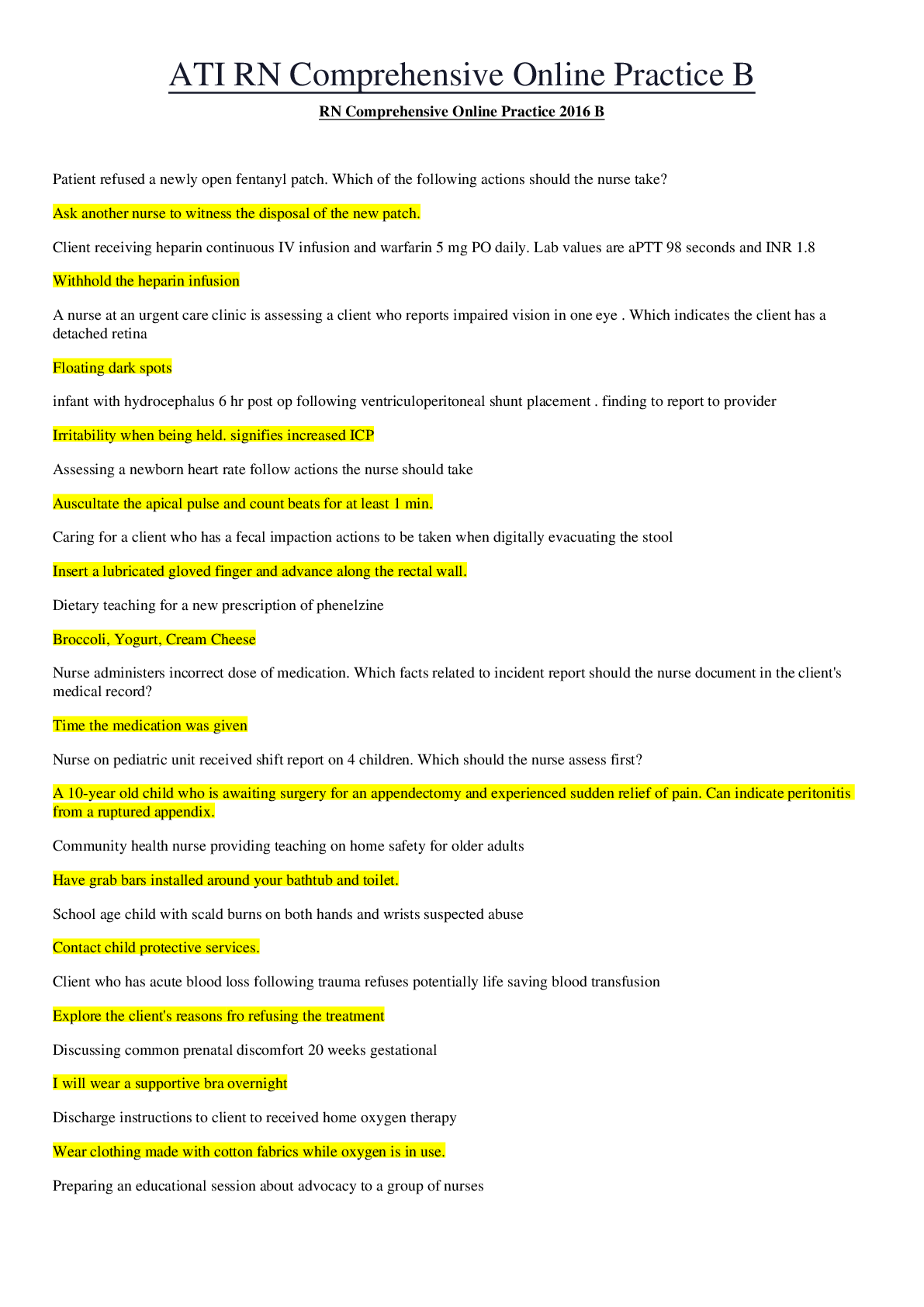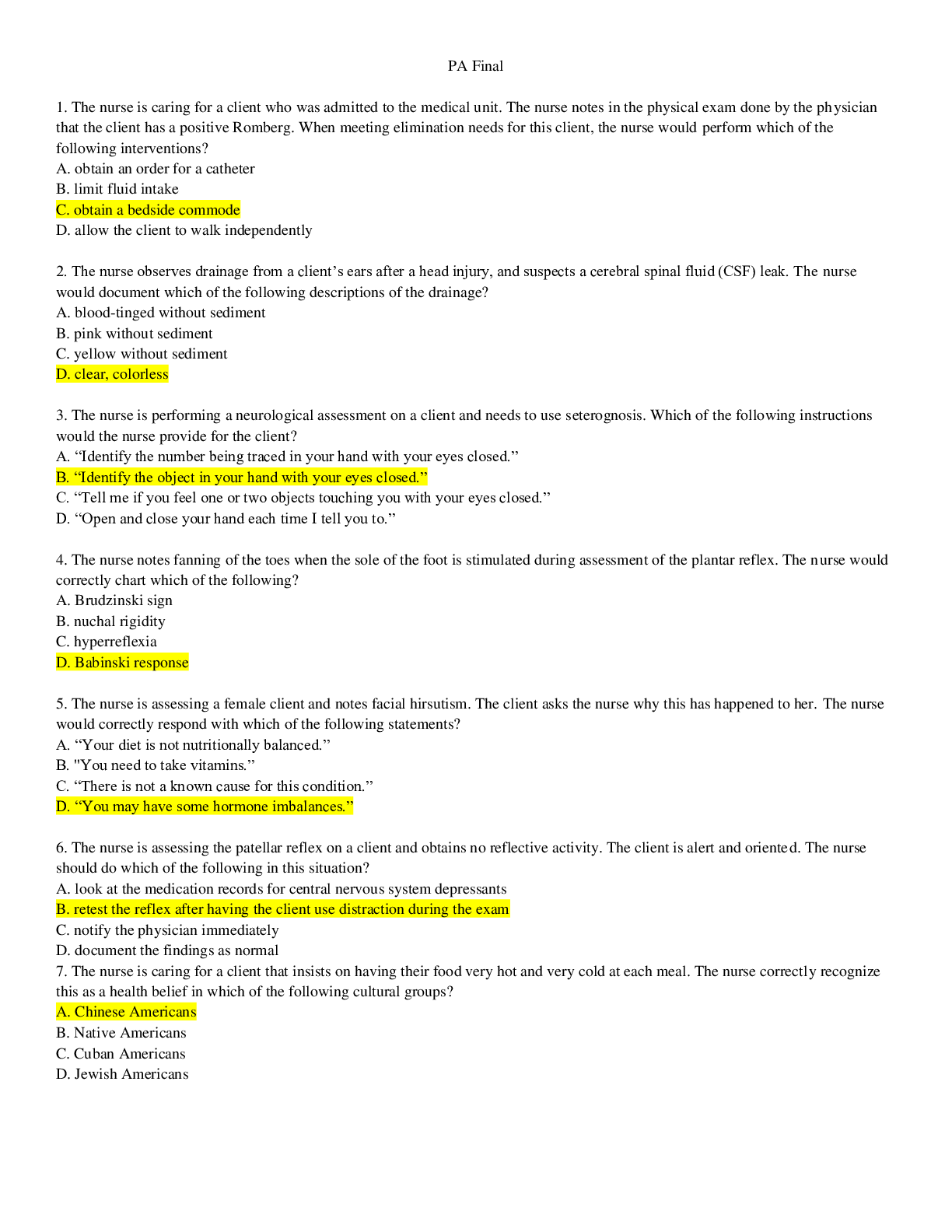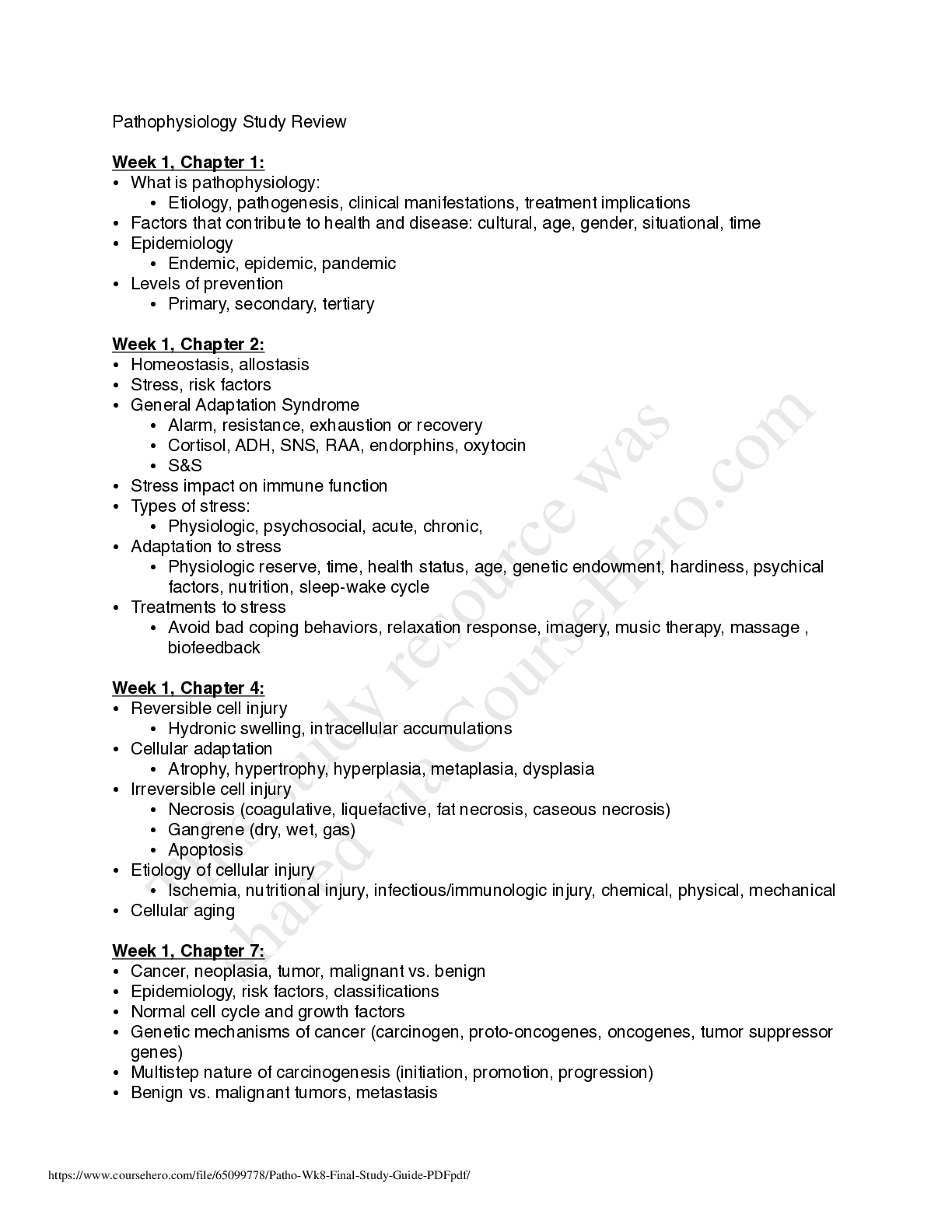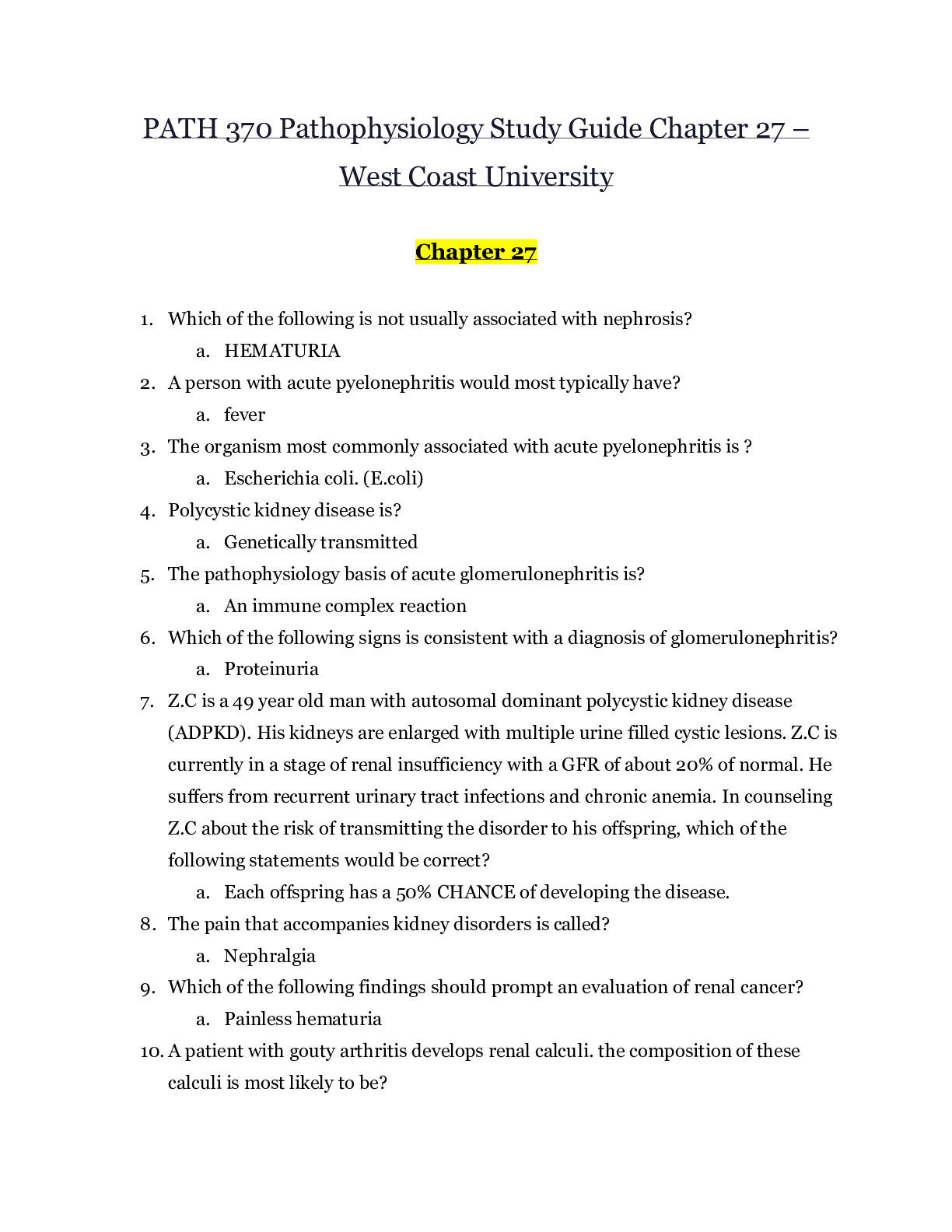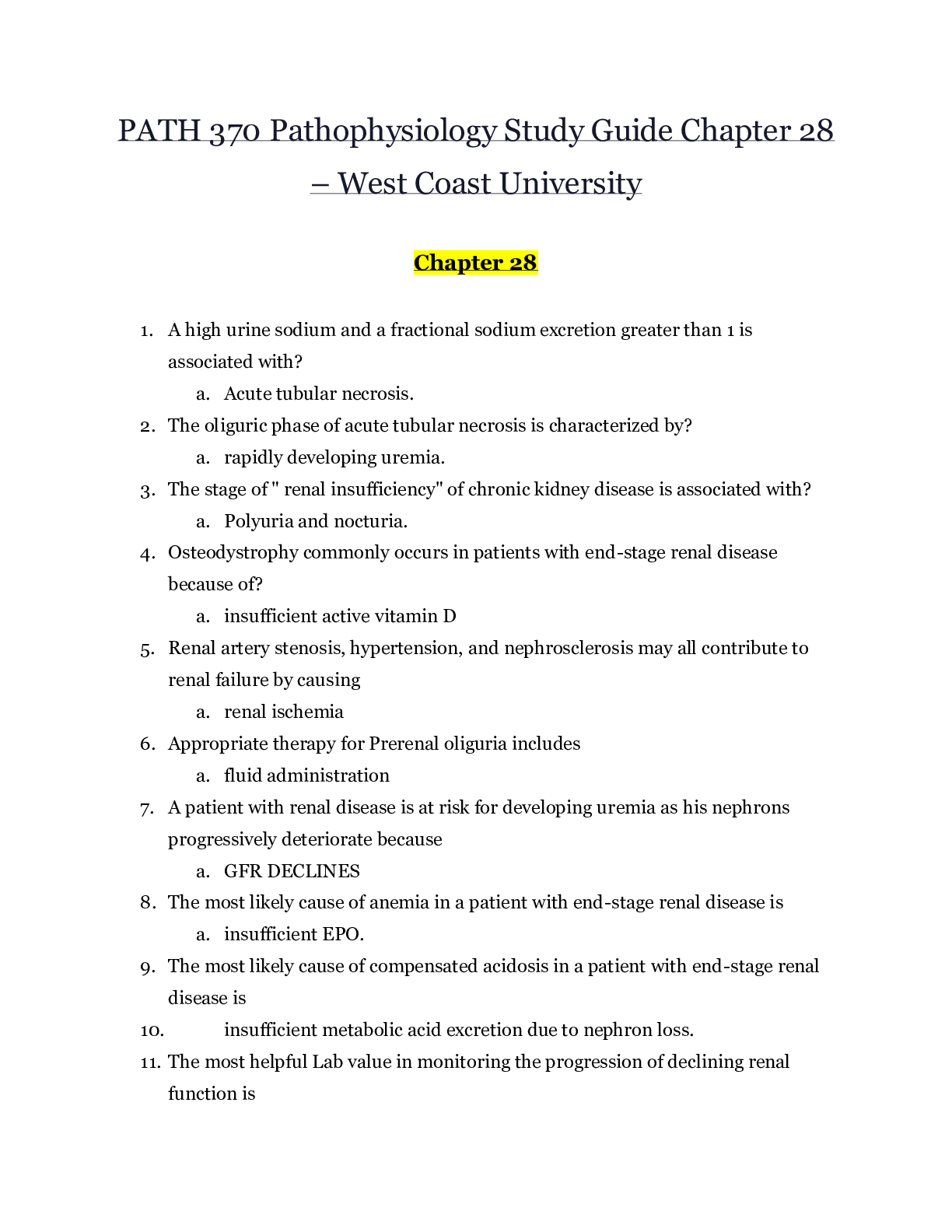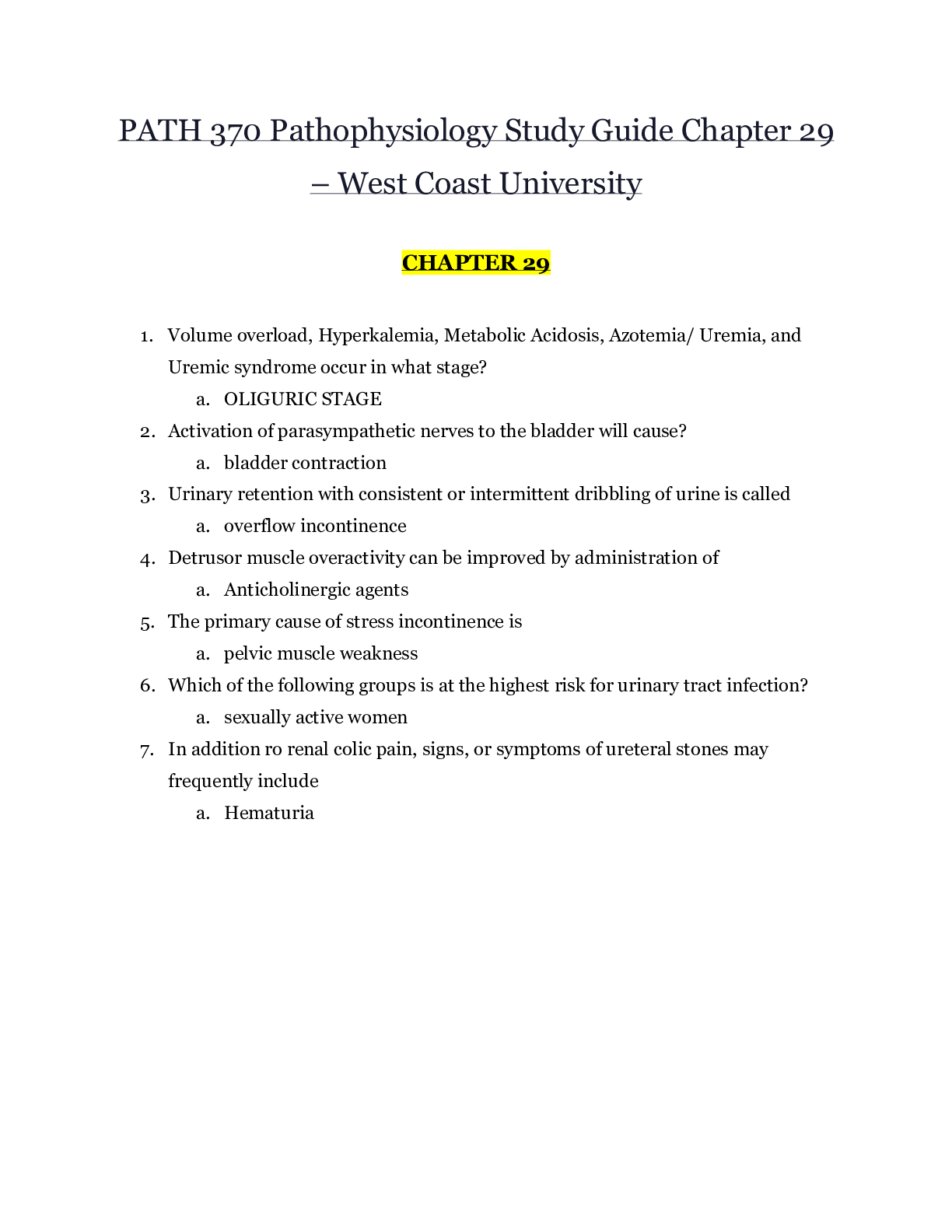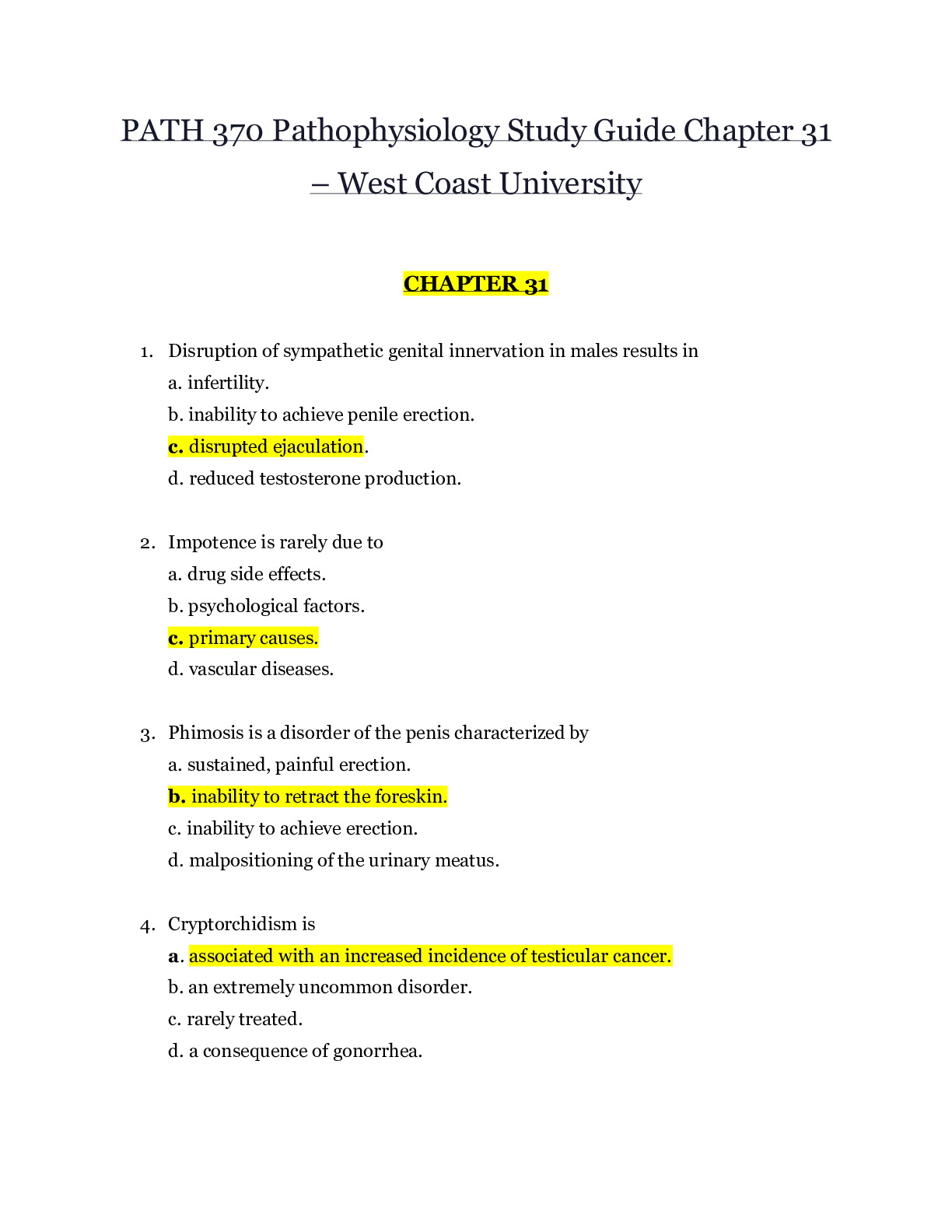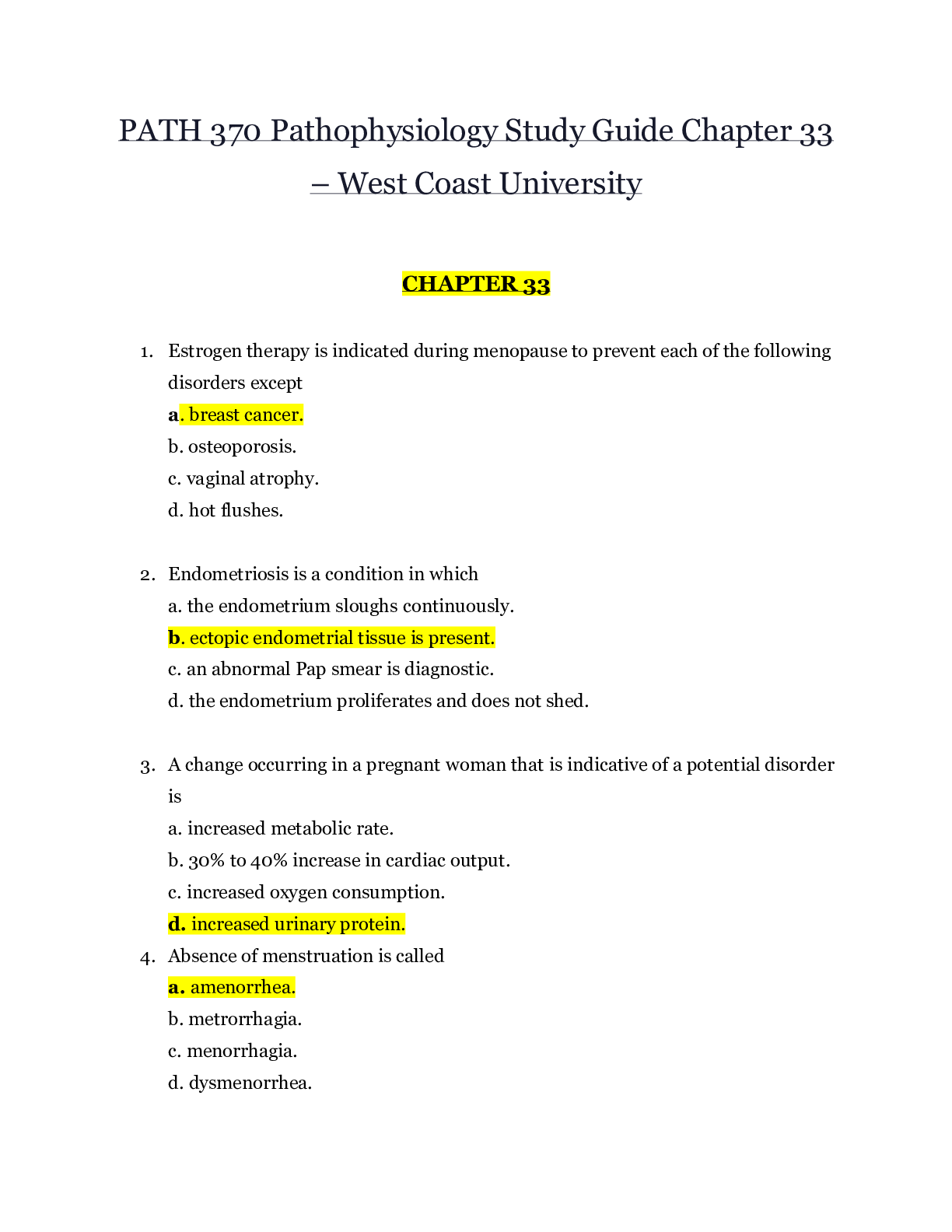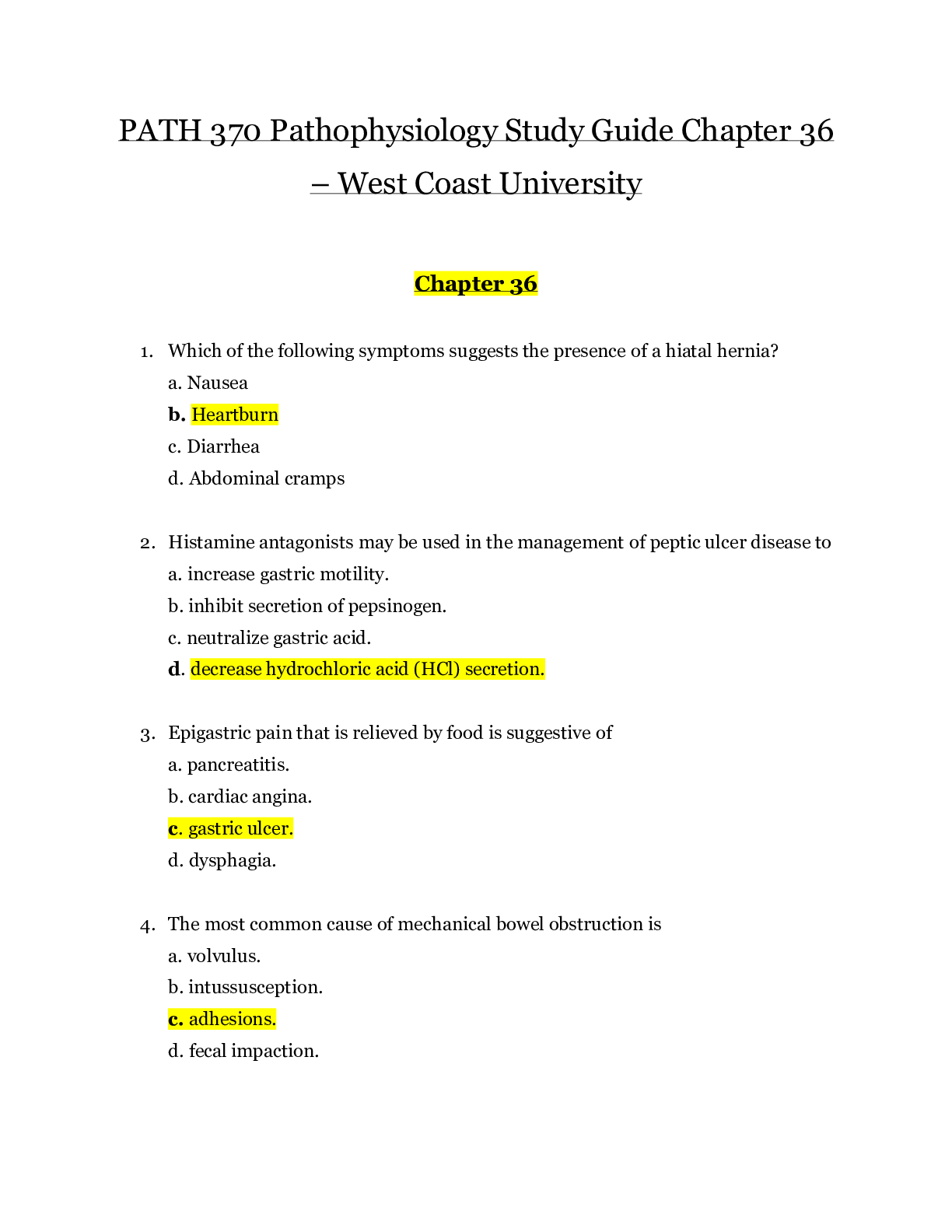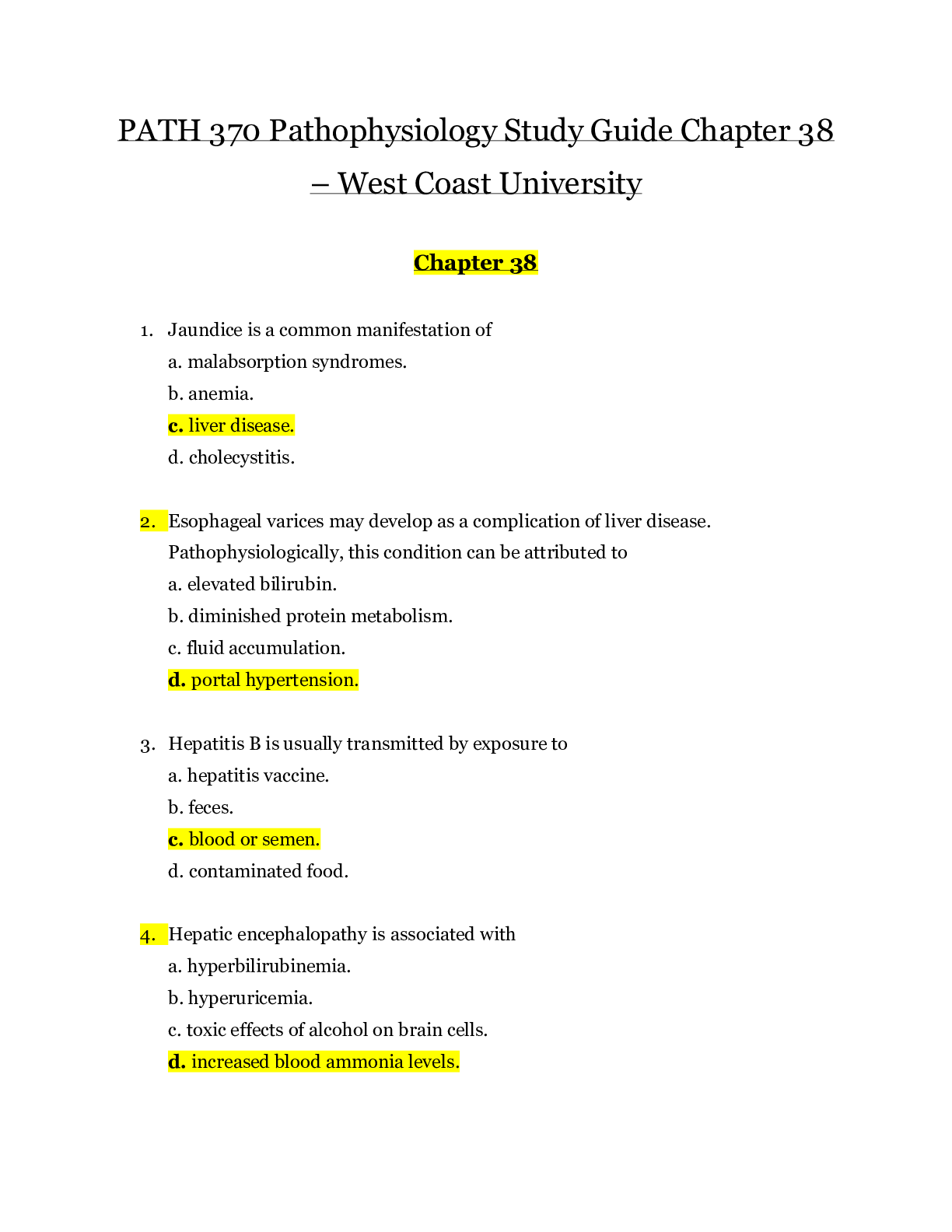Pathophysiology > EXAM > PATH 370 Pathophysiology Study Guide Chapter 40 – West Coast University | PATH370 Pathophysiology (All)
PATH 370 Pathophysiology Study Guide Chapter 40 – West Coast University | PATH370 Pathophysiology Study Guide Chapter 40
Document Content and Description Below
PATH 370 Pathophysiology Study Guide Chapter 40 – West Coast University Chapter 40 1. Slow mentation a. Addison disease b. Acromegaly c. Aldosteronism d. Myxedema 2. Hypertension ... a. Addison disease b. Acromegaly c. Aldosteronism d. Myxedema 3. Hyperglycemia a. Addison disease b. Acromegaly c. Aldosteronism d. Myxedema 4. Hypotension a. Addison disease b. Acromegaly c. Aldosteronism d. Myxedema 5. Growth hormone excess in adults a. results in the condition of acromegaly. b. leads to abnormally tall stature. c. is associated with hypoglycemia. d. is usually asymptomatic. 6. An increase in ADH secretion occurs in response to a. a decrease in serum osmolality. b. dehydration. c. hypervolemia. d. hyponatremia. 7. Antidiuretic hormone (ADH) increases a. sodium reabsorption in the distal tubule of the kidney. b. potassium secretion in the distal tubule of the kidney. c. water reabsorption in the collecting tubule of the kidney. d. urinary output. 8. A clinical finding consistent with a diagnosis of syndrome of inappropriate ADH secretion (SIADH) is a. hypovolemia. b. hyponatremia. c. increased osmolality. d. dehydration. 9. Diabetes insipidus is a condition a. resulting from inadequate ADH secretion. b. characterized by oliguria. c. associated with anterior pituitary dysfunction. d. characterized by glycosuria. 10. Synthesis of thyroid hormones a. is increased by thyrotropin-inhibiting factor. b. occurs in perifollicular C cells. c. is stimulated by ACTH. d. is inhibited by iodine deficiency. 11. In comparison to triiodothyronine (T3), thyroxine (T4) a. has greater biological activity. b. is more abundant in the circulation. c. has a shorter half-life. d. binds to nuclear receptors with greater affinity. 12. Clinical manifestations of Graves disease may include a. tremor. b. cold intolerance. c. lethargy. d. weight gain. 13. Graves disease is a. a secondary endocrine disorder. b. associated with autoantibodies to TSH receptors. c. characterized by high serum TSH levels. d. untreatable. 14. Propylthiouracil may be used to treat hyperthyroidism because it a. destroys thyroid gland cells. b. inhibits the release of TSH. c. suppresses production of autoantibodies. d. inhibits thyroid hormone synthesis. 15. Myxedema coma is a severe condition associated with a. hypothyroidism. b. hyperthermia. c. acute cortisol insufficiency. d. pheochromocytoma. 16. Clinical manifestations of hypoparathyroidism a. are similar to those occurring with hypermagnesemia. b. result from decreased neuromuscular excitability. c. are similar to those occurring with hypokalemia. d. result from decreased serum ionized calcium. 17. The formation of active vitamin D a. occurs in the skin. b. depends on hydroxylation in the kidney. c. is dependent on oral intake of vitamin D. d. is necessary for normal potassium metabolism. 18. Adrenocortical hormones are all derived from the common precursor molecule a. progesterone. b. corticoglobulin. c. ACTH. d. cholesterol. 19. A clinical finding that is consistent with a diagnosis of adrenocortical insufficiency is a. hypokalemia. b. hypoglycemia. c. hypertension. d. moon face. 20. What effect would adrenocortical insufficiency have on an individual's response to surgical stress? a. More prone to hyperglycemia b. Decreased sensitivity to anesthesia c. More susceptible to hypertensive crisis d. More prone to hypotension 21. Which response to an injection of ACTH indicates a primary adrenal insufficiency? a. No change in serum glucocorticoid level b. An increase in serum glucocorticoid level c. A decrease in serum glucose level d. An increase in serum ACTH level 22. A laboratory finding that would help confirm the diagnosis of aldosterone deficiency is a. hypernatremia. b. hyperkalemia. c. hypokalemia. d. hypoglycemia. 23. The signs and symptoms of adrenocortical hormone excess may occur from either a primary or secondary disorder. A symptom associated with primary Cushing syndrome is a. hyperpigmentation. b. hypotension. c. hyperglycemia. d. hyperkalemia. 24. Congenital adrenal hyperplasia (adrenogenital syndrome) results from a. cortisol excess. b. testosterone-secreting tumor. c. exogenous androgens. d. blocked cortisol production. [Show More]
Last updated: 2 years ago
Preview 1 out of 5 pages
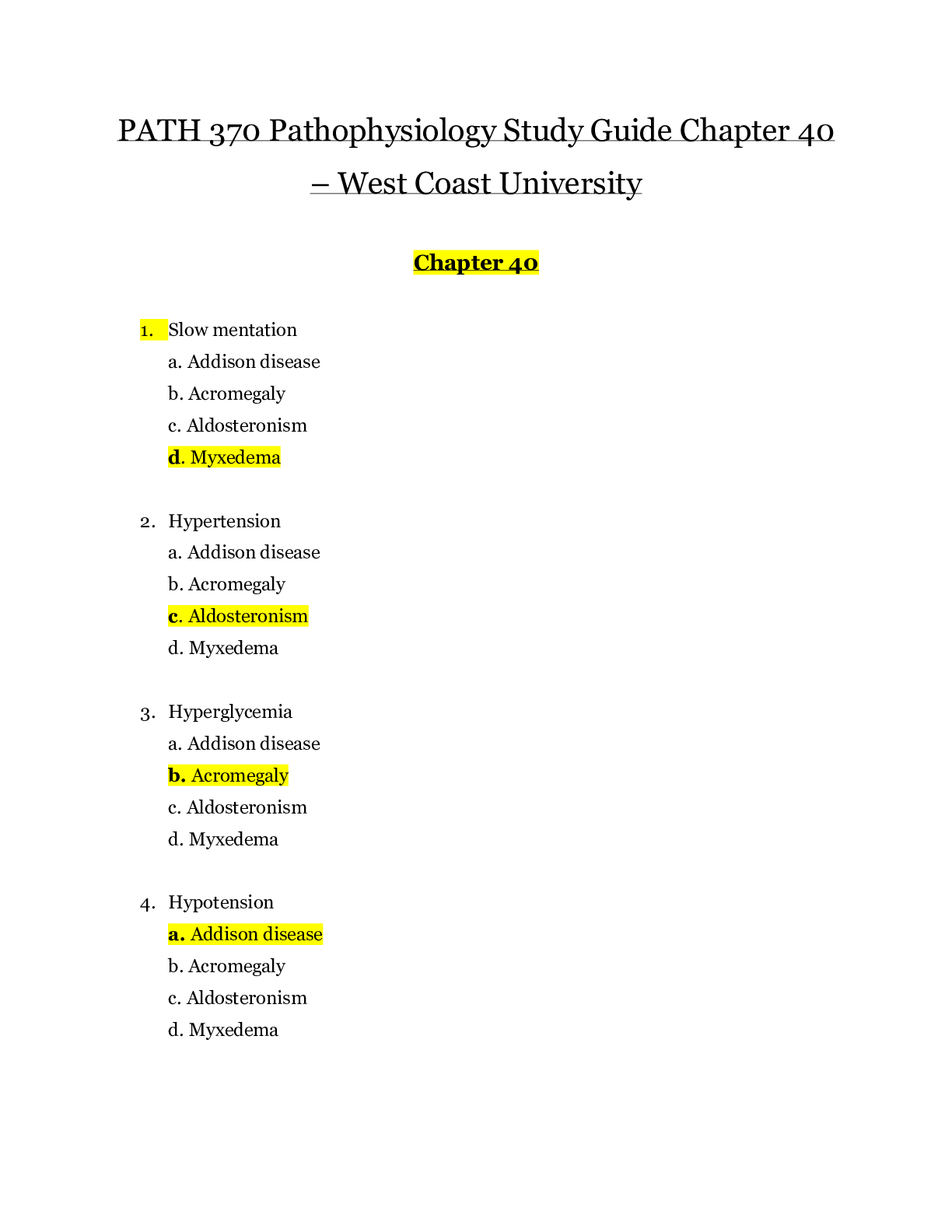
Buy this document to get the full access instantly
Instant Download Access after purchase
Buy NowInstant download
We Accept:

Reviews( 0 )
$8.50
Can't find what you want? Try our AI powered Search
Document information
Connected school, study & course
About the document
Uploaded On
Jul 28, 2020
Number of pages
5
Written in
Additional information
This document has been written for:
Uploaded
Jul 28, 2020
Downloads
0
Views
85








 – University of the People.png)
